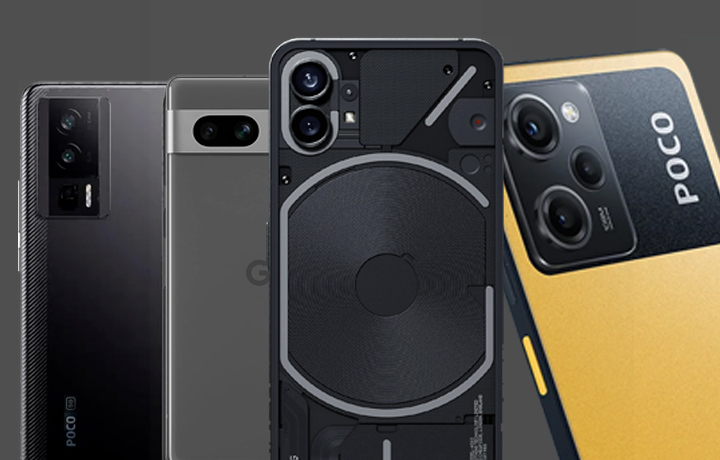Best 2023 Budget Smartphones for Photography
Pixel 7A:
If photography stands as a top priority, then the Google Pixel 7A emerges as an excellent mid-range contender. Despite its modest appearance, the Pixel 7A boasts an appealing aesthetic and robust water resistance thanks to its metal frame and camera bump, further enhanced by a delightful light blue color variant.
The display, a Geo-led panel, likely bearing the ‘G’ for reference, delivers vivid visuals with HDR10 certification and brightness, complemented by stereo speakers that offer satisfactory audio output. Fueling the Pixel 7A is Google’s Tensor G2, the same powerhouse within the Pixel 7 and 7 Pro, ensuring smooth performance even when pushing graphics in demanding games like Genshin Impact.
Noteworthy is the 64-megapixel Sony IMX 787 sensor, a newcomer to the Pixel series and a rarity among smartphones, except for the ZTE Axon 40 from the previous year. Google’s user-friendly Pixel camera app emphasizes simplicity, catering to both casual and experienced photographers with its stress-free interface. As anticipated from a Google device, the Pixel 7A produces visually pleasing photos with natural color tones, thanks to Google’s adept processing algorithms.
One minor drawback is that the Pixel 7A’s focus can occasionally falter, but the device’s swift shutter speed compensates by capturing surprisingly sharp images, even in motion and portrait mode photography. Speaking of which, portrait shots exhibit quality, effectively handling challenges like windy conditions and producing a pleasant bokeh-style background blur. In stable ambient environments, sharpness prevails, though occasional focus hiccups persist. Snapping multiple shots is advisable to secure the best result. In low-light scenarios, the Pixel 7A remains competitive, although noticeable noise is typical among mid-range smartphones.
Switching to the secondary lens—a 13-megapixel ultra-wide-angle variant—is an option, delivering consistent results with natural tones, albeit slightly less detail. Low-light performance sees a dip, as expected. The absence of a telephoto lens aligns with mid-range norms, offering up to eight times digital zoom and various modes, including portrait and night sight.
For video recording, the Pixel 7A offers a choice between full HD and 4K resolutions, with the latter supporting 60 frames per second. However, 4K at 60fps omits the speech enhancement feature. Video capture quality is respectable, characterized by crisp visuals and occasional focusing quirks. Audio capture excels, offering a surround sound effect that captures clear vocals from all directions.
Rounding off the Pixel 7A’s camera capabilities is the 13-megapixel front-facing camera, producing decent results but shining brightest in ideal lighting conditions. Crisp and detailed shots demand stability and optimal lighting. Impressively, the front-facing camera supports 4K recording, a notable feat considering the norm of full HD. The speech enhancement feature proves valuable for focusing on your voice amidst bustling outdoor environments, perfect for vlogging scenarios.
Poco F5 vs F5 Pro:
Another affordable alternative is the Poco F5 or the Poco F5 Pro. Both are well-specced MIUI mobiles that can handle Android games, with vibrant OLED screens and stereo speakers. They share the same camera hardware, with slight differences in shooting experience.
The Poco F5 Pro has eye focus and motion track and focus features. Both phones produce capable photos with decent lighting, particularly good portrait effects. They handle harsh contrast and trickier conditions well, with good balance and low-light performance.
Both phones offer similar camera modes, including portrait and night mode. Both can capture full 64-megapixel images. Video recording maxes out at 4K on the Poco F5 and up to 8K on the F5 Pro. Video quality is sharp, with good colors, clear audio, and respectable stabilization. The 16-megapixel front-facing shooter is capable for selfies even in different lighting conditions.
Nothing Phone 1:
Another cracking choice is the Nothing Phone 1. It may have stolen headlines with its flashy back, but it’s actually a solid all-rounder for a similar price to the Pixel. It’s got impressive gaming grunt, a similar stock Android vibe, and some capable camera tech headed up by Sony’s IMX 766 sensor, which is found in a lot of 2022 smartphones. More often than not, this does a great job, although some of my recent picks on the Nothing Phone still occasionally look rather soft, as if the focus didn’t quite get it together in time.
The Nothing Phone handles HDR situations well while capturing a good amount of detail in darker areas without blowing out the lighter bits. A bright blue sky will often look exactly that, rather than washed out. Likewise, I haven’t seen any kind of lens flare or other issues when shooting in harsh lighting.
The Nothing Phone is also a blinder when it comes to portrait shots, even with fast-moving subjects, although it now seems to take a while to process some portrait snaps, remaining unresponsive until it’s done. That’s something I didn’t notice at first, so maybe it’s been introduced by an update.
In low light, the Nothing Phone sadly doesn’t perform as admirably despite the optical image stabilization. You’ll see plenty of grain and noise creeping into your pics, not to mention blur with any kind of motion. The focus definitely struggles more in low light. You can use the flash to blind your subject if you want to light them up.
The 50-megapixel ultra-wide-angle lens uses Samsung’s GN1 sensor, and you’ll get some distortion around the edges of your photos and the usual color morphing. But the actual picture quality is almost as good as any images taken with the main sensor. This is more prone to saturation in brighter lights and not as capable in dimmer conditions, but it is still one of the better ultra-wide shooters at this price point.
For video, you can record up to 4K resolution, although it’s capped at 30 frames per second. After an update, the footage looked more natural, without the artificial color boost that made it look cartoon-like. Image stabilization works against shakes and bumps, and audio capture is respectable.
The 16-megapixel front-facing sensor does a decent job in all kinds of lighting, with plenty of detail packed into every pic, even in strong light. The portrait mode is also up to snuff, though things do get soft in lower light. Go Next for more…
- Check out the latest prices here:
- Google’s Pixel 7A.
- Poco F5 And F5 Pro
- Nothing Phone 1






